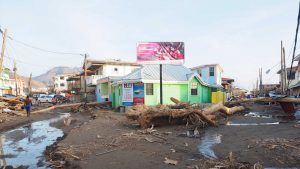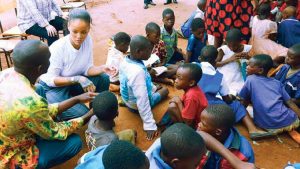Through the Clara Lionel Foundation, Barbados-born singer and businesswoman Robyn “Rihanna” Fenty is supporting climate justice, writes Laurie Goering.
When Hurricane Maria slammed into Dominica in 2017, 160 mph winds flattened just about everything — wiping out houses, schools, health clinics, and farms — and left the island nation without electricity for months.
As climate change heats the oceans, whipping up more frequent and damaging hurricanes, it is extracting a particularly heavy toll on Caribbean islanders, who per person emit just a sixth of the climate-wrecking fossil fuel emissions of their American neighbors.
“The communities of the Caribbean are not responsible for climate change, but they are bearing the brunt of it,” says Justine Lucas, executive director of the Clara Lionel Foundation. The foundation has been responding to Caribbean disasters since shortly after it was founded in 2012 by Barbados-born singer and businesswoman Robyn “Rihanna” Fenty to honor her grandparents.
Hurricanes, floods, and other disasters generally prompt an initial outpouring of emergency help. But when media attention fades, Caribbean communities are often left to recover with little in the way of resources to restore basic services, much less try to figure out how to become more resilient before the next storm hits.
“We saw that reproductive health clinics wouldn’t get back up and running for years. Women had no access to services for long periods of time,” says Lucas.
Where Climate Action and Racial Justice Meet
The foundation launched with a donation of radiotherapy equipment to the Barbados hospital that treated Rihanna’s grandmother for cancer. What followed was a decade of experimentation that saw the charity move from providing emergency aid after disasters to supporting broader resilience-strengthening efforts in the Caribbean.
More recently, in the wake of George Floyd’s murder by a Minneapolis police officer in 2020, the foundation has also staked out space in a small but growing philanthropical niche: the overlap between climate action and racial justice.
Globally, climate change impacts, from hurricanes to heat waves, are hitting the poorest and most vulnerable hardest, threatening their basic human rights — but such groups rarely receive much financial help to improve their resilience.
Well under 10% of international climate finance goes to local action on climate change, the London-based International Institute for Environment and Development estimates. In the U.S., only about 1.3% of grant money handed out by major national environmental organizations to combat climate change ends up in the hands of climate justice groups with Black, Latino, Indigenous, or other leaders of color, according to the Georgia-based Donors of Color Network.
“This space is not crowded,” noted Lucas, who in 2016 joined the Clara Lionel Foundation, which aims to boost resilience to climate change threats through advocacy, education, infrastructure projects, and, critically, building ongoing partnerships with local communities that might otherwise struggle to find support from bigger funders.
Investing in Local Communities
I spoke with Lucas just after she returned from the Dominican Republic, where the foundation has helped strengthen a Santo Domingo health clinic to better withstand storms and outfitted it with solar panels that can provide cheap electricity even if the power grid is down.
“It’ll be a hub during emergencies, a place to do triage, a safe place for people to go,” she said.
In addition, the solar panels will save an estimated US$13,000 a month in energy costs even in normal times, money the clinic can channel back into services.
Early this year, the Clara Lionel Foundation granted US$15 million to local organizations and communities in the Caribbean and the U.S. led by women, youth, LGBTQ+, Indigenous, Black, or other people of color, and focused on climate justice issues.
At the Clara Lionel Foundation, much of the work is rooted in the understanding that climate disasters, which are growing in frequency and intensity, do not impact all communities equally, with communities of color and island nations facing the brunt of climate change. This is why CLF prioritizes both climate resilience and climate justice work across the U.S. and Caribbean. Rihanna
Altogether, the foundation has leveraged about US$80 million in grants since 2012, backing more than 100 projects, from the U.S.-based The Solutions Project, which promotes renewable energy for all as a way of improving social welfare and racial equity, to efforts to climate-proof access to sexual and reproductive health services after destructive weather disasters in countries like Barbados, the Dominican Republic, and Trinidad.
“Resiliency doesn’t mean every structure on the island is protected, but it does start with the resiliency of critical facilities such as health clinics and schools. It’s about communities being supported locally to move through disasters,” Lucas said.
The Caribbean has faced six above-average Atlantic hurricane seasons in a row, according to the U.S. National Oceanic and Atmospheric Administration, and scientists are predicting much worse is in store as climate-changing emissions continue to rise, despite a raft of promises to
slash them.
“It’s pretty much guaranteed these countries will face disasters in the next five years. There’s an urgency here,” Lucas said, warning “It will take a massive influx of funding to support resilience in the Caribbean.”
Lessons for Social Investors
The Clara Lionel Foundation’s work and other similarly aligned philanthropic initiatives demonstrate a few key lessons for those working to build climate justice.
Funders of climate justice work, who are essentially trying to solve problems created by unequal power, should be particularly mindful of listening to the communities they work with and letting them lead. The community’s needs — not the ideas of funders or outside consultants — must shape the solutions invested in.
“Those who understand the problem intimately need to be the decision-makers,” noted Gloria Walton, CEO of The Solutions Project, in an interview last year.
Efforts to shift power balances also take time, so making long-term grants can provide multiple benefits. It can allow new funders in the space time to gain their footing and experiment. But it can also give those they support the longer-term stability they need to hire staff and position themselves to begin seeking structural change, rather than simply carrying out a series of shorter one- or two-year projects.
The Clara Lionel Foundation now aims to have many of its grants last at least three years — and some partners have been supported as long as five or six years, Lucas said.
“If you’re acting responsibly in the philanthropy space, you need to look at the bigger systems change that’s needed,” she said, such as helping hurricane-vulnerable communities develop and implement their own systems for cutting risks and strengthening resilience, in addition to simply adding solar panels to a clinic.
Similarly, groups pushing for climate justice are often small, volunteer-led community organizations without a lot of support staff, and many do not necessarily have a track record or experience in dealing with grant processes. Funders can help these organizations by making everything from grant applications to reporting requirements simpler.
Solomé Lemma, the executive director of California-based Thousand Currents, which backs social movements in the Global South, believes funders urgently need to move more money to frontline communities. To do so, funders should simplify and adapt their own processes rather than asking those they fund to change theirs, which can divert energy, attention, and resources from such groups’ core mission.
Flexibility in funding is key. Both pandemics and hurricanes can throw communities and projects into disarray. When such setbacks happen, funders need to “show up with kindness and understanding” rather than strict reporting demands, Lucas said, if they want to build lasting trust.
Finally, finding high-profile advocates and allies — including in government — can help funders push change ahead. Barbados Prime Minister Mia Mottley, an outspoken advocate for building climate change resilience, lambasted world leaders at last year’s United Nations Climate Change conference of the Parties in Glasgow, Scotland, for doing too little to cut emissions and help communities adapt to surging threats.
“When will we, as world leaders, address the pressing issues that are truly causing our people angst and worry?” Mottley demanded. “Are we so blinded and hardened we can no longer appreciate the cries of humanity?”
Rihanna, who Mottley declared a Barbados national hero last year, has used her international profile and hefty social media following — more than 100 million followers on Twitter and 130 million on Instagram — to help open doors and push for change.
Effective climate action “doesn’t have to be innovative technology solutions,” Lucas said. She hopes more funders looking for ways to drive action on climate change will, like Rihanna’s foundation, think about backing communities and justice movements.
Laurie Goering
Laurie Goering is the climate change editor at the Thomson Reuters Foundation. As part of her work, she developed and mentors a network of more than 100 climate change journalists in sub-Saharan Africa, Asia, and Latin America, in an effort to improve reporting on climate change around the globe.
She previously worked as a foreign correspondent for “The Chicago Tribune” newspaper for 15 years based in New Delhi, Kuwait, Johannesburg, Rio de Janeiro, Havana, Mexico City, and London. Goering has reported from about 80 countries, including covering the second Gulf War in Iraq and conflict in Colombia, and opening the first post-revolution U.S. newspaper bureau in Cuba.
This article was originally published in Social Investor magazine, a publication by Chandler Foundation looking at the challenges of social impact, featuring insights from a diverse range of social change leaders.








Comments (0)